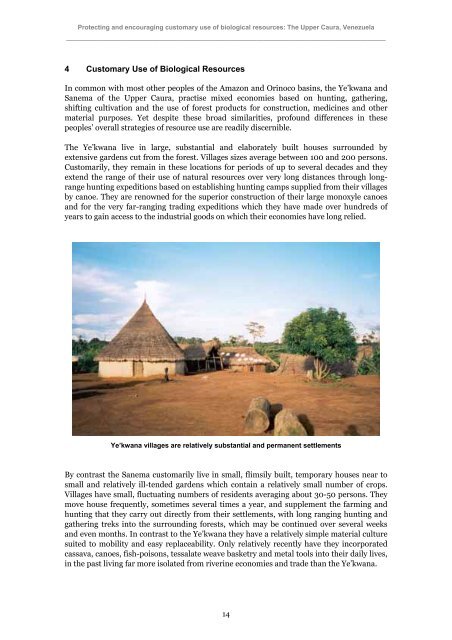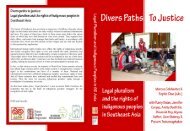The Upper Caura, Venezuela - Forest Peoples Programme
The Upper Caura, Venezuela - Forest Peoples Programme
The Upper Caura, Venezuela - Forest Peoples Programme
Create successful ePaper yourself
Turn your PDF publications into a flip-book with our unique Google optimized e-Paper software.
Protecting and encouraging customary use of biological resources: <strong>The</strong> <strong>Upper</strong> <strong>Caura</strong>, <strong>Venezuela</strong>_________________________________________________________________________________________4 Customary Use of Biological ResourcesIn common with most other peoples of the Amazon and Orinoco basins, the Ye’kwana andSanema of the <strong>Upper</strong> <strong>Caura</strong>, practise mixed economies based on hunting, gathering,shifting cultivation and the use of forest products for construction, medicines and othermaterial purposes. Yet despite these broad similarities, profound differences in thesepeoples’ overall strategies of resource use are readily discernible.<strong>The</strong> Ye’kwana live in large, substantial and elaborately built houses surrounded byextensive gardens cut from the forest. Villages sizes average between 100 and 200 persons.Customarily, they remain in these locations for periods of up to several decades and theyextend the range of their use of natural resources over very long distances through longrangehunting expeditions based on establishing hunting camps supplied from their villagesby canoe. <strong>The</strong>y are renowned for the superior construction of their large monoxyle canoesand for the very far-ranging trading expeditions which they have made over hundreds ofyears to gain access to the industrial goods on which their economies have long relied.Ye’kwana villages are relatively substantial and permanent settlementsBy contrast the Sanema customarily live in small, flimsily built, temporary houses near tosmall and relatively ill-tended gardens which contain a relatively small number of crops.Villages have small, fluctuating numbers of residents averaging about 30-50 persons. <strong>The</strong>ymove house frequently, sometimes several times a year, and supplement the farming andhunting that they carry out directly from their settlements, with long ranging hunting andgathering treks into the surrounding forests, which may be continued over several weeksand even months. In contrast to the Ye’kwana they have a relatively simple material culturesuited to mobility and easy replaceability. Only relatively recently have they incorporatedcassava, canoes, fish-poisons, tessalate weave basketry and metal tools into their daily lives,in the past living far more isolated from riverine economies and trade than the Ye’kwana.14
















